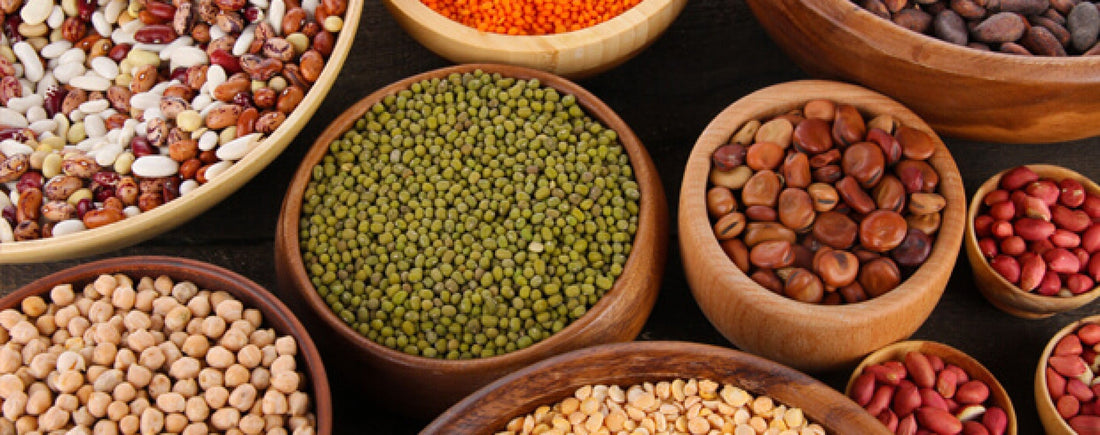If you want an inexpensive and delicious way to improve your heart health, add more beans to your diet. Beans are a low-fat, high-fiber protein source, and they provide multiple phytochemicals that help reduce your risk of many health conditions, including heart disease.
Beans belong to a family of foods known as legumes, which are plants whose seeds are contained within pods. Legumes also include lentils, soybeans and peanuts, and peas and green beans. Beans are harvested from within the seed pod of the legume and then dried or eaten fresh.
Many health organizations, including the American Heart Association and the World Health Organization, agree that the healthiest diet is a plant-based diet that includes beans. An analysis of food intake patterns and risk of death from coronary artery disease in seven different countries revealed that higher legume consumption was associated with an 82 percent reduction in heart-attack risk. (1)
Here are five specific ways that beans can improve your heart health:
1) Lower Cholesterol—Beans are a good source of soluble fiber, which can bind cholesterol and its precursors in the digestive system and eliminate them from the body before they get into circulation. A recent analysis of 10 clinical studies showed that bean consumption decreases total cholesterol and LDL-cholesterol levels (2), which are both associated with higher risk of heart disease. Furthermore, research from the Department of Nutrition at the Harvard School of Public Health found that the consumption of just one serving of beans per day is associated with a 38 percent lower risk of heart attack. (3)
2) Lower Blood Pressure—Since elevated blood pressure increases the risk of heart disease, maintaining a normal blood pressure is heart-healthy. According to the Health and Nutrition Examination Survey, people who ate beans had a 47 percent lower risk of elevated blood pressure than those who didn’t include beans in their diet. (4) This research suggests that eating beans can help maintain healthy blood pressure. Several other studies have found that eating a diet rich in beans and other legumes can lead to greater elasticity in the blood vessels, which results in lower blood pressure. (5,6)
3) Reduce Inflammation and Oxidative Stress—Beans contain several phytochemicals, including polyphenols, terpenoids, and anthocyanin, that can reduce the inflammation and oxidative stress that contribute to heart disease. (7) Beans that have dark-colored seed coats, such as black beans, red kidney beans, and pinto beans, have higher levels of these beneficial phytochemicals.
4) Maintain Healthy Blood Glucose and Insulin Levels—Several studies show that eating more beans and other legumes lowers the risk of diabetes. Since diabetes is a known risk factor for developing heart disease, a legume-rich diet can help prevent both diabetes and heart disease.
In addition to fiber, the healthy anti-inflammatory elements in beans, as mentioned above, can help with the prevention of diabetes, since chronic inflammation is considered a risk factor for the development of diabetes. At this time, the American Diabetes Association feels that there is sufficient evidence that eating beans and other legumes, as part of a healthy diet, can help prevent diabetes. (8)
5) Provide Heart-Healthy Vitamins—Beans are a rich source of several vitamins and minerals that are associated with improved heart health, including niacin, magnesium, zinc, and potassium. One B vitamin in particular, folate, decreases levels of the amino acid homocysteine, which can damage blood vessel walls. When present in high concentrations, homocysteine has been linked to an increased risk of heart attacks and strokes. By decreasing levels of homocysteine, folate can help reduce the risk of heart disease. (9,10)
Although there are differing opinions on the best amount to include in the diet, evidence suggests that eating as little as 1/3 to 1/2 cup of dry beans per day can help decrease the risk of cardiovascular disease.
Ingredients:
Drain the beans.
In a soup pot, bring the vegetable stock and beans to a boil. Add 1 teaspoon of cumin and the bay leaves. Reduce the heat, and simmer at a low rolling boil until the beans are tender, about 1 hour.
Meanwhile, heat the oil over medium heat in a large sauté pan; add the leeks, pepper, red chili flakes, and aminos. Sauté for 3 to 4 minutes. Add the yam and carrots. Continue to sauté for 5 minutes, and then add the tomatoes. Add the remaining 2 teaspoons of cumin, the cinnamon, oregano, cilantro, and tomato paste.
Add the yam mixture to the beans after the beans have cooked 30 minutes, and continue to simmer. Add more vegetable stock if necessary. The stew will be done when the beans, yams, and carrots are soft to the touch. Remove the bay leaves before serving.
Serves 4
Nutritional Facts (per 1 1/2-cup serving)
Calories 418, Total fat 4.5 g, Saturated fat 1.1 g, Carbohydrates 64 g, Protein 31.1 g
References
1. Menotti, A, et al. Food intake patterns and 25-year mortality from coronary artery disease: cross-cultural correlations in the Seven Countries Study. The Seven Countries Research Group. Eur J Epidemiol 1999 Jul;15(6):507-15.
2 .Bazzano, L.A., et al., Non-soy legume consumption lowers cholesterol levels: A meta-analysis of randomized
controlled trials. Nutr Metab Cardiovasc Dis, 2009.
3. Kabagambe, E.K., et al., Decreased consumption of dried mature beans is positively associated with urbanization and nonfatal acute myocardial infarction. J Nutr, 2005. 135(7): p. 1770-5.
4. Papanikolaou Y, Fulgoni VL, 3rd. Bean consumption is associated with greater nutrient intake, reduced systolic blood pressure, lower body weight, and a smaller waist circumference in adults: results from the National Health and Nutrition Examination Survey 1999-2002. J Am Coll Nutr 2008;27:569-76.
5. Zahradka, P., et al. Daily non-soy legume consumption reverses vascular impairment due to peripheral artery disease. Atherosclerosis. 2013 Oct;230(2):310-4. Epub 2013 Aug 6.
6. Hanson, MG, et al. Lentil-based diets attenuate hypertension and large-artery remodeling in spontaneously hypertensive rats. Br J Nutr. 2014 Feb;111(4):690-8. Epub 2013 Sep 24.
7. Xu BJ, Yuan SH, Chang SK. Comparative analyses of phenolic composition, antioxidant capacity, and color of cool season legumes and other selected food legumes. J Food Sci 2007;72:S167-77.
8. McIntosh, M, et al. A diet containing food rich in soluble and insoluble fiber improves glycemic control and reduces hyperlipidemia among patients with type 2 diabetes mellitus. Nutr Rev 2001. Feb;59(2):52-5.
8. American Diabetes Association, Position Statement. Nutrition recommendations and interventions. Diabetes Care. 2008; 31:S61-S78.
9. Holt, E.M., et al., Fruit and vegetable consumption and its relation to markers of inflammation and oxidative
stress in adolescents. J Am Diet Assoc, 2009. 109(3): p. 414-21.
10. Mente, A., et al., A systematic review of the evidence supporting a causal link between dietary factors and
coronary heart disease. Arch Intern Med, 2009. 169(7): p. 659-69.
Health
Ready to take control of your health? Download the Chopra App for personalized well-being guidance you can access anywhere.
*Editor’s Note: The information in this article is intended for your educational use only and is not a substitute for professional medical advice, diagnosis, or treatment. Always seek the advice of your physician or other qualified health providers with any questions you may have regarding a medical condition and before undertaking any diet, supplement, fitness, or other health programs.
Beans belong to a family of foods known as legumes, which are plants whose seeds are contained within pods. Legumes also include lentils, soybeans and peanuts, and peas and green beans. Beans are harvested from within the seed pod of the legume and then dried or eaten fresh.
Many health organizations, including the American Heart Association and the World Health Organization, agree that the healthiest diet is a plant-based diet that includes beans. An analysis of food intake patterns and risk of death from coronary artery disease in seven different countries revealed that higher legume consumption was associated with an 82 percent reduction in heart-attack risk. (1)
Here are five specific ways that beans can improve your heart health:
1) Lower Cholesterol—Beans are a good source of soluble fiber, which can bind cholesterol and its precursors in the digestive system and eliminate them from the body before they get into circulation. A recent analysis of 10 clinical studies showed that bean consumption decreases total cholesterol and LDL-cholesterol levels (2), which are both associated with higher risk of heart disease. Furthermore, research from the Department of Nutrition at the Harvard School of Public Health found that the consumption of just one serving of beans per day is associated with a 38 percent lower risk of heart attack. (3)
2) Lower Blood Pressure—Since elevated blood pressure increases the risk of heart disease, maintaining a normal blood pressure is heart-healthy. According to the Health and Nutrition Examination Survey, people who ate beans had a 47 percent lower risk of elevated blood pressure than those who didn’t include beans in their diet. (4) This research suggests that eating beans can help maintain healthy blood pressure. Several other studies have found that eating a diet rich in beans and other legumes can lead to greater elasticity in the blood vessels, which results in lower blood pressure. (5,6)
3) Reduce Inflammation and Oxidative Stress—Beans contain several phytochemicals, including polyphenols, terpenoids, and anthocyanin, that can reduce the inflammation and oxidative stress that contribute to heart disease. (7) Beans that have dark-colored seed coats, such as black beans, red kidney beans, and pinto beans, have higher levels of these beneficial phytochemicals.
The Science Behind Inflammation and Oxidative Stress
Researchers have identified chronic inflammation and oxidative stress as two primary factors in the development of heart disease. A vicious cycle can begin when free radicals (unstable molecules) cause damage to blood vessel walls in a process known as oxidation. The immune system responds with a natural inflammatory response that is intended to heal the damage; however, when inflammation becomes chronic, the damaged areas can develop plaque (cholesterol) deposits, which can lead to clogging of the arteries.4) Maintain Healthy Blood Glucose and Insulin Levels—Several studies show that eating more beans and other legumes lowers the risk of diabetes. Since diabetes is a known risk factor for developing heart disease, a legume-rich diet can help prevent both diabetes and heart disease.
Diving into the Science of Beans and Diabetes Prevention
The benefit of beans in the prevention of diabetes is likely due to the cumulative effect of their nutritional aspects, rather than just a single aspect. The high fiber content of beans slows down the release of sugar in the body, thus avoiding spikes in blood sugar. This is helpful because when blood sugar spikes, the body makes more insulin to lower the sugar levels. Over time, the body becomes resistant to the higher levels of insulin.In addition to fiber, the healthy anti-inflammatory elements in beans, as mentioned above, can help with the prevention of diabetes, since chronic inflammation is considered a risk factor for the development of diabetes. At this time, the American Diabetes Association feels that there is sufficient evidence that eating beans and other legumes, as part of a healthy diet, can help prevent diabetes. (8)
5) Provide Heart-Healthy Vitamins—Beans are a rich source of several vitamins and minerals that are associated with improved heart health, including niacin, magnesium, zinc, and potassium. One B vitamin in particular, folate, decreases levels of the amino acid homocysteine, which can damage blood vessel walls. When present in high concentrations, homocysteine has been linked to an increased risk of heart attacks and strokes. By decreasing levels of homocysteine, folate can help reduce the risk of heart disease. (9,10)
How Many Beans Do I Need?
Although there are differing opinions on the best amount to include in the diet, evidence suggests that eating as little as 1/3 to 1/2 cup of dry beans per day can help decrease the risk of cardiovascular disease.
Help Your Heart, Help the Environment
There are other reasons your heart may sing when you choose beans as your healthy protein source instead of an animal source. Studies have shown that the footprint on the environment is smaller for a serving of beans than for a serving of meat. In addition, encouraging the production of legumes, including beans, is good for the soil. As they grow, legumes fix nitrogen into the soil, which turns inert nitrogen into biologically available nitrogen. This reduces the need for chemical fertilizers. These nitrogen-fixing crops improve the environmental sustainability of annual cropping systems.Tips to Reduce Gas and Bloating from Beans
Some people avoid eating beans because they experience gas, bloating, and abdominal discomfort. However, this side effect of bean consumption can be reduced in several ways:- Soak dry beans overnight and discard the water before cooking—this reduces the oligosaccharide content of the beans, which is a sugar that is digested by the bacteria in our intestines, thus producing gas.
- Cook beans with carminative herbs and spices such as ground fennel, cumin, ginger, and bay leaves. These herbs and spices are used in traditional ethnic cooking to reduce the gas and bloating that can be associated with beans.
- Chewing dry-roasted fennel seeds after eating a meal that includes beans can also help.
Black Bean and Vegetable Stew
Try this delicious recipe from The Chopra Center Cookbook.Ingredients:
- 1 cup black beans, sorted, rinsed, and soaked overnight in water
- 4 cups vegetable stock
- 1 teaspoon plus 2 teaspoons cumin
- 2 bay leaves
- 1 teaspoon ghee or olive oil
- 1 cup chopped leeks or onions
- 1/2 teaspoon black pepper
- 1 pinch red chili flakes
- 1 tablespoon Bragg Liquid Aminos or tamari
- 1 medium yam, peeled and cubed
- 2 cups carrots cut into 1/4-inch slices
- 1 cup diced tomatoes
- 1/2 cup fresh corn or frozen (defrosted)
- 2 teaspoons cinnamon
- 2 teaspoons oregano
- 1 cup chopped fresh cilantro
- 2 tablespoons tomato paste
Drain the beans.
In a soup pot, bring the vegetable stock and beans to a boil. Add 1 teaspoon of cumin and the bay leaves. Reduce the heat, and simmer at a low rolling boil until the beans are tender, about 1 hour.
Meanwhile, heat the oil over medium heat in a large sauté pan; add the leeks, pepper, red chili flakes, and aminos. Sauté for 3 to 4 minutes. Add the yam and carrots. Continue to sauté for 5 minutes, and then add the tomatoes. Add the remaining 2 teaspoons of cumin, the cinnamon, oregano, cilantro, and tomato paste.
Add the yam mixture to the beans after the beans have cooked 30 minutes, and continue to simmer. Add more vegetable stock if necessary. The stew will be done when the beans, yams, and carrots are soft to the touch. Remove the bay leaves before serving.
Serves 4
Nutritional Facts (per 1 1/2-cup serving)
Calories 418, Total fat 4.5 g, Saturated fat 1.1 g, Carbohydrates 64 g, Protein 31.1 g
References
1. Menotti, A, et al. Food intake patterns and 25-year mortality from coronary artery disease: cross-cultural correlations in the Seven Countries Study. The Seven Countries Research Group. Eur J Epidemiol 1999 Jul;15(6):507-15.
2 .Bazzano, L.A., et al., Non-soy legume consumption lowers cholesterol levels: A meta-analysis of randomized
controlled trials. Nutr Metab Cardiovasc Dis, 2009.
3. Kabagambe, E.K., et al., Decreased consumption of dried mature beans is positively associated with urbanization and nonfatal acute myocardial infarction. J Nutr, 2005. 135(7): p. 1770-5.
4. Papanikolaou Y, Fulgoni VL, 3rd. Bean consumption is associated with greater nutrient intake, reduced systolic blood pressure, lower body weight, and a smaller waist circumference in adults: results from the National Health and Nutrition Examination Survey 1999-2002. J Am Coll Nutr 2008;27:569-76.
5. Zahradka, P., et al. Daily non-soy legume consumption reverses vascular impairment due to peripheral artery disease. Atherosclerosis. 2013 Oct;230(2):310-4. Epub 2013 Aug 6.
6. Hanson, MG, et al. Lentil-based diets attenuate hypertension and large-artery remodeling in spontaneously hypertensive rats. Br J Nutr. 2014 Feb;111(4):690-8. Epub 2013 Sep 24.
7. Xu BJ, Yuan SH, Chang SK. Comparative analyses of phenolic composition, antioxidant capacity, and color of cool season legumes and other selected food legumes. J Food Sci 2007;72:S167-77.
8. McIntosh, M, et al. A diet containing food rich in soluble and insoluble fiber improves glycemic control and reduces hyperlipidemia among patients with type 2 diabetes mellitus. Nutr Rev 2001. Feb;59(2):52-5.
8. American Diabetes Association, Position Statement. Nutrition recommendations and interventions. Diabetes Care. 2008; 31:S61-S78.
9. Holt, E.M., et al., Fruit and vegetable consumption and its relation to markers of inflammation and oxidative
stress in adolescents. J Am Diet Assoc, 2009. 109(3): p. 414-21.
10. Mente, A., et al., A systematic review of the evidence supporting a causal link between dietary factors and
coronary heart disease. Arch Intern Med, 2009. 169(7): p. 659-69.
Health
Ready to take control of your health? Download the Chopra App for personalized well-being guidance you can access anywhere.
*Editor’s Note: The information in this article is intended for your educational use only and is not a substitute for professional medical advice, diagnosis, or treatment. Always seek the advice of your physician or other qualified health providers with any questions you may have regarding a medical condition and before undertaking any diet, supplement, fitness, or other health programs.






















